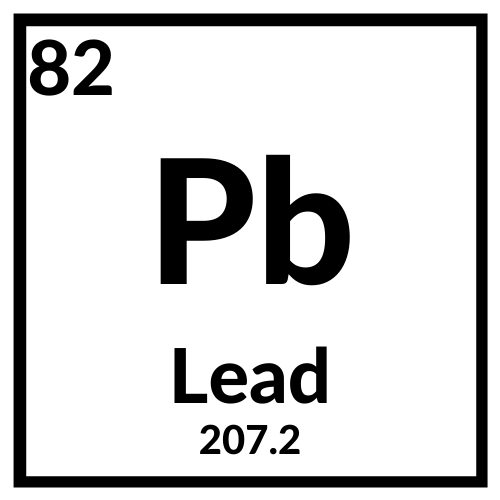
How To Remove Lead From Drinking Water
December 21, 2021 3:36 pm Comments Off on How To Remove Lead From Drinking Water
Lead is a common metal known for its malleability, resilience, and versatility. It is used in many products including paint, petrochemicals, pottery, pipes and plumbing materials, roof flashing, and gutters.
Unfortunately, lead is toxic to humans when ingested or absorbed through the skin. If you drink water with high levels of lead for long period, you may eventually experience lead poisoning – a serious ailment with severe symptoms.
One of the best ways to protect yourself from lead exposure is to filter your drinking water. Water filtration can remove a variety of metals including lead, arsenic, cadmium, chromium, copper, nickel, and zinc.
In this guide, I’ll explain how lead can enter the body and how it is dangerous to your health. I’ll then showcase the best water filters in Australia for lead removal.
Contents
What Is Lead?
Why Is Lead Dangerous To Humans?
How Does Lead Get Into Drinking Water?
How To Test For Lead In Drinking Water?
What Are Acceptable Lead Levels For Drinking Water?
Getting Tested For Lead Exposure
How To Remove Lead From Drinking Water
Frequently Asked Questions
The Best Lead Removal Water Filters In Australia
Wrapping Up
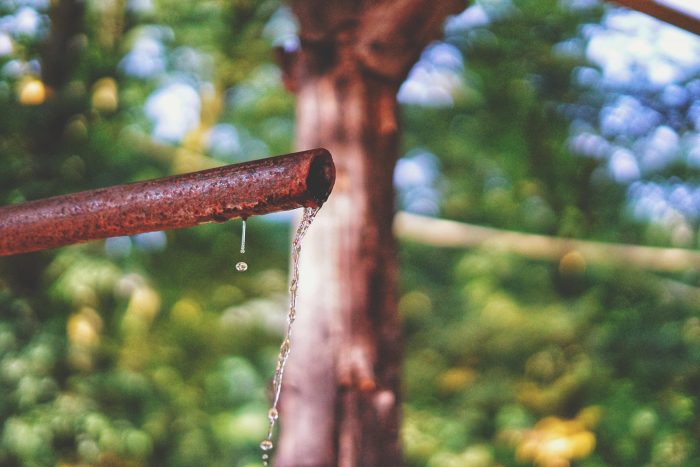
What Is Lead?
Lead is a chemical element that is abundant in nature. It is classified as a heavy metal, which means it has a higher density than other common metals like iron, nickel, and copper.
The softness and malleability of lead have made it a popular building and crafting material for thousands of years. Ancient civilisations used lead to bolt together buildings, create eating utensils, to build fighting tools and much more.
In modern times, lead has often been used in roofing, gutters, water tanks, and water pipes and fittings. The use of lead in water infrastructure is one of the reasons why lead is sometimes found in drinking water.
Why Is Lead Dangerous To Humans?
Lead is easily absorbed by the human body via inhalation, ingestion, or skin absorption. Once absorbed, it will accumulate in the bones, blood and tissues of very quickly. If the level of lead in the body reaches a high level, it can have a toxic effect and interfere with normal biological processes.
If you ingest a significant amount of lead over a short period of time, you may experience the following symptoms:
- Irritability
- Headaches
- Abdominal pain
- Loss of appetite
- Memory loss
- Nerve pain in the hands or feet
- Weakness
If you are exposed to extremely high levels over a short period, anaemia, severe fatigue, kidney damage, and brain damage may occur.
Lead contamination is particularly dangerous to pregnant women as it can pass through the placental barrier. This means a growing foetus can be impacted by lead toxicity. Lead can damage a growing baby’s nervous system, affecting their cognition and intelligence later on in life.
Prolonged lead exposure has the following symptoms:
- Nausea and poor appetite
- Abdominal pain
- Inability to focus
- Irritability
- Forgetfulness
- Depression
People who are exposed to lead for many years also have a higher risk of several chronic health conditions including high blood pressure, heart disease, reduced fertility, and kidney disease.

How Does Lead Get Into Drinking Water?
There are several ways for lead to enter your drinking water, including:
Pipework and Fittings
Fortunately lead pipes have rarely been used in Australian civil infrastructure projects. This means you shouldn’t have to worry about lead contamination occurring as water is being delivered to your home through your local council’s water infrastructure.
However, many Australian homes do have internal brass plumbing fittings which contain some lead. This is particularly true of older homes where brass plumbing fittings can contain as much as 10% lead but 2.4 to 4% is more common.
When leading-containing fittings are submerged in water for long periods, the lead can begin to dissolve into the water, causing lead contamination of the water supply.
Older homes may also have lead-containing solder on their metal pipes and fittings. The lead in this solder can also dissolve into the water flowing through the pipes.
This type of lead contamination is more likely to happen in locations where the water acidic or low in mineral content, as it will leech lead out faster.
There are several factors which determine how much lead contamination can occur from lead in pipework and plumbing fittings in the home, including:
- The chemistry of your water (how acidic or alkaline it is)
- Water mineral content
- Any protective scales or coatings inside the pipes and fittings
- The amount of lead in the pipework and fittings
- The level of wear and corrosion in the pipework and fittings
- Water temperature
- How long water is left sitting against a fitting or pipe that contains lead
The use of lead in plumbing is a particularly dangerous problem if you have soft or acidic water as the water can dissolve lead faster.
Rain water is considered quite acidic, with a pH of between 5 and 5.5 pH (7pH is considered neutral). This is why homeowners on tank water should be vigilant about lead and copper contamination.
If you have hard water, a layer of minerals can form over metal plumbing fittings, offering some protection from lead dissolution. Calcium carbonate minerals can also combine with soluble lead, creating a layer of lead carbonate or lead sulfate over the pipes and fittings.
If there is dissolved carbon dioxide in the carried water, soluble lead bicarbonate may also form. Oxygenated water may dissolve lead as lead(II) hydroxide. Drinking water containing lead hydroxide can be quite dangerous
Taps
There is also some evidence to suggest taps can contribute to lead contamination. One recent study tested 212 water samples from Australian homes where the water has been left to stagnate in a tap for 9 hours.
The study found that copper was present in all samples, while lead was present in 56% of samples.
In 8% of the samples collected, the level of lead found in the water was greater than 10 micrograms per litre. This is above the recommend limit in the Australian Drinking Water Guidelines. One household had a lead level of 89 micrograms – which is a dangerous level of lead.
The NSW Health drinking water guidelines suggest that water left standing in taps for several hours should be flushed and used for non-food related purposes, like watering plants.
Roofing Materials
The malleability and durability of lead has made it an extremely popular roofing material in Australia. As a result, many Australian homes have some lead in their roof sheeting, gutters, or flashing.
Unfortunately, this can sometimes result in lead sedimentation being added to rain water that is collected from the roof.
Water Tanks
Older metal water tanks sometimes have metal panels or solder containing lead. Over time, water can leach this lead from these parts of the tank, contaminating your drinking water.
It’s worth noting that new tanks can sometimes have issues with lead.
There was a recent case of an Australian company selling stainless steel water tanks in Australia with solder that contained lead. Consumers who had been using the tanks for several years were found to have elevated lead levels in their blood
Environmental Contamination
Industrial, commercial, and mining activities can result in high levels of lead being emitted into the environment. This includes lead particles, which can pollute rain water tanks, lakes, rivers, dams, and streams.
If you gather water from one of these contaminated sources, you may be consuming water with high levels of lead.
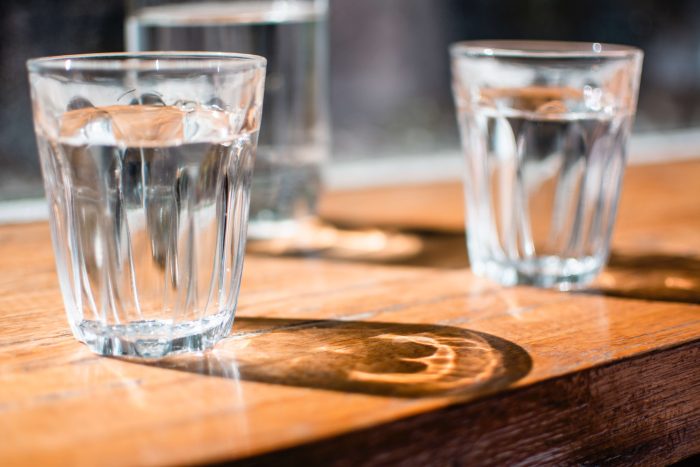
How To Test For Lead In Drinking Water?
When lead is dissolved in water, it is completely odourless, colourless, and tasteless. This makes it impossible to determine if your water is contaminated using your senses alone.
Fortunately, its relatively simple to test for lead using an in-home lead water testing kit. These kits are very affordable and will give you a reasonable indication if there are elevated lead levels in your drinking water.
To obtain a more accurate reading, you can send a sample of your water to a laboratory for testing. There are several labs around Australia that specialise in the testing of drinking water for lead and other contaminants.
What Are Acceptable Lead Levels For Drinking Water?
According to the Australian Drinking Water Guidelines, drinking water should contain less than 0.01 milligrams of lead per litre (10 micrograms per litre). This figure was recently adjusted down from 0.05 milligrams per litre (50 micrograms per litre).
Unfortunately, there is currently no government mandated monitoring of lead levels in Australian water. State governments only encourage local water utilities (LWUs) to test for lead and make those test results publicly available.
As a result, many LWUs only provide sparse data on the contaminants in their water or no data at all. It’s often up to the homeowner or business owner to check the level of lead in their water supply.
Getting Tested For Lead Exposure
If you suspect that you or a family member has been exposed to lead, visit your doctor for further advice. They may recommend that you have tests performed to measure the amount of lead in your blood.
In Australia, the National Health and Medical Research Council (NHMRC) recommends that if a person has a blood lead level greater than 5 µg/dL (micrograms per decilitre), the source of exposure should be investigated and reduced.
This is particularly true if the person is a child or pregnant woman, as they are more at risk of health problems from lead exposure.

Time needed: 30 minutes.
How To Remove Lead From Drinking Water
- Eliminate the Source of Lead Contamination
If you have discovered that the source of your lead contamination is under your control, you may be able to isolate or remove it.
This strategy can work if you have lead contaminated water tanks, internal pipework, roofing, or flashing that can be removed or repaired. You can simply purchase a new gutter, install a new tank or replace old plumbing fixtures.
Of course, this solution can be expensive. It may cost several thousand dollars to replace all of the parts of your home which contain lead.
It’s also not a viable solution if the source of lead contamination is out of your control, like a dam which is contaminated by industrial pollution. - Flush Your Taps/Pipes
If you have confirmed that lead is being introduced by internal fittings, taps, or pipes, you can simply discard the affected water.
All you need to do is run your water for 2-3 minutes to remove water that has been stagnant in your home’s plumbing for an extended period, leaching lead. You can safely use this water on your plants or do your dishes.
If your lead issue involves your water tanks or roofing materials, this strategy will not work as all of the water supply entering your home already will be contaminated. - Clean Your Aerators
Aerators are the small screens attached to the bottom of tap spouts. Their main role is to aerate the water and dissipate active chlorine.
However, they can also catch debris in your water, including lead. If you are concerned about lead build-up, clean your aerators every 1-2 months. It takes about 30 seconds to remove and clean them. - Use Cold Water For Cooking
Lead dissolves more rapidly in hot water, which makes your hot water more likely to harbour high lead levels. Make it a habit to cook and prepare baby formula using cold water.
- Install Water Filtration
One of the simplest and most cost-effective ways to reduce contaminants in your water supply is to install a high-quality water filtration system.
However, it is important to understand that only certain water filters can reduce lead. You will need to look for filters that are NSF/ANSI 53 certified for lead.
The NSF/ANSI 53 certification means that the product in question has been proven to reduce specific contaminants in laboratory studies. NSF/ANSI 53 also tests the material safety and structural integrity of a product.
Water filters that meet this standard can be extremely effective at reducing lead. The NSF/ANSI 53 certified WC04 carbon block, for example, has been proven to reduce over 99.3% of lead in water at 6.5pH and 8.5pH.
Frequently Asked Questions
How Do I Know If Lead Is In My Drinking Water?
Lead is colourless and tasteless when it is dissolved in water, so it is impossible to determine if it is an issue without testing.
However, there are a couple of factors which can indicate an increased likelihood of lead in your water:
- Acidic water
If you have noticed blue/green staining in your showers or sinks, it is a sign that you may have acidic water, which is breaking down your copper lines. Acidic water can also leech lead from brass fittings. - Symptoms of Lead Poisoning
If you have been feeling unwell lately and your symptoms match those of lead poisoning you should speak to a doctor immediately and have your water tested. Symptoms include Irritability, Loss of appetite, Weight loss, Sluggishness and fatigue, Abdominal pain, Vomiting, Constipation, Hearing loss and Seizures. - Presence of objects or environmental factors which increase lead risk
If you have a lead roof, live in an area with high lead pollution or use a water source that may be contaminated, you should have your water tested.
Do All Carbon Water Filters Reduce Lead?
To reduce lead, you will need to use a speciality carbon block filter rated for heavy metal reduction. Fortunately, they are quite a few on the market, including the popular WC04, Omnipure L5515 and Doulton Ultracarb.
Is It Safe To Shower In Water Containing Lead?
Lead cannot penetrate the skin, so bathing in lead-contaminated water is not considered a health risk.
However, there is still a chance that it may be inadvertently swallowed. Children would be at a greater risk of accidentally ingesting shower/bath water so it would be inadvisable to let them bathe in contaminated water.
Are Lead Pipes Common In Australia?
However, there are other sources of potential lead contamination including brass plumbing fittings, cheap taps, lead roofs, solder containing lead, and environmental pollution.
Is The Australian Government Doing Anything To Reduce Lead Exposure?
The 2022 edition of the National Construction Code (NCC) has changed the amount of allowable lead in plumbing products used for drinking water.
After 1 September 2025, any copper alloy plumbing product containing more than 0.25% lead will not be authorised for installation in systems used to convey drinking water.
The Best Lead Removal Water Filters In Australia
Here are the most popular lead reduction filters in Australia:
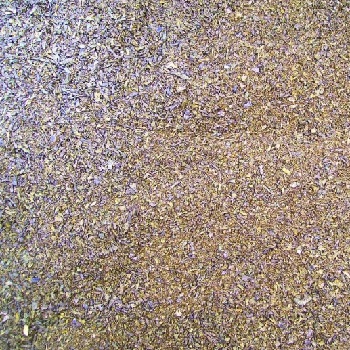
#5 – KDF55
KDF55 (Kinetic Degradation Fluxion) is a water filtration medium made from a combination of copper and zinc.
When oxygenated water flows through this combination of metals, an electrochemical process called reduction/oxidation occurs (called Redox for short).
Redox describes chemical reactions in which atoms have an increase or decrease in oxidation number, which changes their oxidation state.
KDF uses the redox process to make certain contaminants lose or gain electrons. Chlorine, for example, will lose electrons when it passes through KDF, turning into chloride — a harmless electrolyte. This change removes the horrible taste and smell of chlorine from your water.
Some heavy metals, like lead, are also reduced by KDF. As positively charged lead cations pass through KDF, the zinc particles lose 2 electrons (oxidation) and the lead particles gain 2 electrons (reduction).
The lead cations are changed from a soluble state to insoluble and then electroplated onto the copper fragments in the KDF. It is estimated that up to 98% of soluble lead particles can be removed by KDF in this way.
The copper in KDF also performs a bacteriostatic function, preventing bacteria, fungi, and mould from growing inside of the canister.
There are several filters which use KDF55 including:
- AP1025KDF/GAC
10” x 2.5” 5 micron filter with a combination of KDF55 and granular activated carbon. - 1025KDF/GAC
10” x 2.5” 5 micron filter with a combination of KDF55 and granular activated carbon. Slightly more KDF55 content than the AP1025KDF/GAC. - 20” x 4.5” Refillable KDF/ORC Canister
A large 20” x 4.5” canister designed for whole of house filtration systems. Normally used in a twin or triple whole of house system with sediment filters. Combines 1 or 2 kgs of KDF55 with Catalytic Carbon (ORC) which provides an excellent level of heavy metal and chemical reduction.
It’s important to note that the effectiveness of KDF55 will vary based on flow rates, your water’s lead levels, and water usage. Testing is always recommended to ensure that your KDF55 is reducing lead contamination to a safe level.
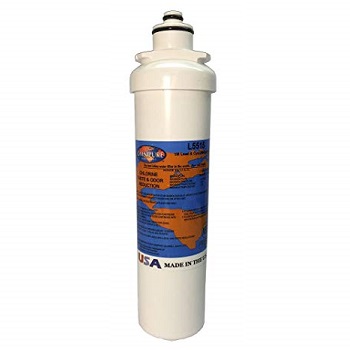
#4 – Omnipure L5515 1 Micron Carbon Filter
Omnipure is one of the world’s leading water filtration companies. They produce high-quality American made products to suit a wide variety of applications.
The Omnipure L5515 is a special 1 micron carbon block filter which does an excellent job of reducing:
- Heavy metals (including lead and mercury)
- Sediment
- Chlorine
- Chloramines
- Chemicals
- Bad Taste and Odours
- Cyst parasites (cryptosporidium, giardia, and Cyclospora)
This filter works with a single or twin L-Series head and is one of the more affordable options for lead reduction. Measures 285mm x 62mm.
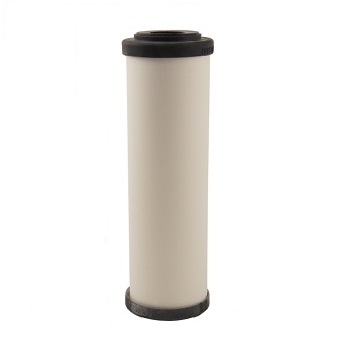
#3 – Ultracarb
The UltraCarb is a 10″ x 2.5″ ceramic canister filter made by UK-based manufacturer Doulton. Doulton was the first company to make ceramic water filters and were responsible for inventing the ceramic candle water filters.
The Ultracarb is a three-stage filter. The first stage is the ceramic outer shell, which can reduce sediment particles down to 0.2 micron in size. It can provide protection against CYST parasites (cryptosporidium, giardia, Cyclospora), protozoa, algae, sand, silt, and sediment.
The next stage is a 1 micron carbon block filter, which will reduce heavy metals (including lead) chemicals, chlorine, chloramines, bad taste and odours.
The final stage is an Ion Exchange Resin. It can remove hazardous metal ions (like lead, cadmium, and copper) from your water, replacing them with more innocuous ions like sodium or potassium.
The UltraCarb is rated at 0.9 microns absolute and will achieve:
- 99% Cysts reduction including live Cryptosporidium 99.999%
- 3% lead reduction
- 95% chlorine reduction at 2PPM
- 99% E.Coli, Shigella, Salmonella, Klebsiella & Cholera reduction
The standard 10” x 2.5” Ultracarb has a Flow rate 1.9 Lpm and capacity of approximately 12 months depending on water quality. It measures 248mm by 72mm and will suit standard 10″ housings. Other part numbers include 21419, CE941. Learn more about the Ultracarb 10″.
There is also a 9” version of the Ultracarb measuring 228mm by 72mm. Learn more about the UltraCarb 9”.
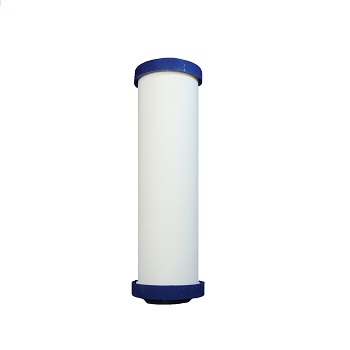
#2 – Cerametix®
The 1025 CeraMetix® is another 10” x 2.5” ceramic filter with several stages of filtration. It is a sophisticated filter which can greatly reduce heavy metals, fluoride, chlorine, chloramines, chlorine by-products like trihalomethanes, sediment, bacteria, and cyst parasites.
The Cerametix® has a fine ceramic outer casing for reduction of sediment, algae, sand, silt, mud and other coarse contaminants.
This outer casing surrounds the AquaMetix® core block — a blend of coconut shell carbon and zeolite minerals. This block can reduce a huge range of contaminants, including heavy metals.
The Cerametix® has been tested in accordance with ANSI/NSF protocols for lead and other heavy metals, cyst, turbidity, particulates, pharmaceutical compounds, chloramines and chlorine reduction (Class 1).
The 10” model is 248mm and will fit any standard 10 inch housing. Its capacities are 5,455 litres for chlorine, 4,546 for lead reduction and 1,700 litres for Fluoride. Learn more about the 1025 CeraMetix 10″ Fluoride Removal Ceramic Water Filter.
There is also a 9” model measure which is 228mm long. It will non standard 9″ housings. This smaller version has 5,455 litres capacity for chlorine, 4,546 for lead reduction and 1,700 litres for Fluoride. Learn more about the 925 CeraMetix 9″ Fluoride Removal Ceramic Water Filter.
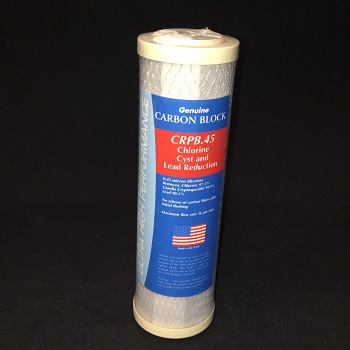
#1 – WC04
The WC04 is an affordable filter which does a wonderful job of removing lead and other contaminants.
It is a 10” x 2.5” product which is compatible with standard 10” housings from manufacturers like QMP. It uses a sediment wrap and 0.45 micron carbon block to reduce:
- Sediment (including sand, silt, and mud)
- Chlorine
- Chloramines
- Chlorine by-products like trihalomethanes
- PFAs
- Volatile Organic Compounds (VOCs)
- Pesticides
The WC04 is particularly good at reducing heavy metals like lead and mercury. It has a lead removal rate of 99.3% in water between 6.5 and 8.5 pH.
It is an NSF/ANSI 53 Health Effects rated filter which has been proven to reduce a range of contaminants that can make drinking water unsafe. Read more about the WC04.
Whole Of House Filtration Options
There are several filters available for whole of house filtration systems which can reduce lead, including the 2045LRC0.5. This filter is compatible with big blue filter housings, which can be used to filter all of the water coming into your home or business.
The 2045LRC0.5 is very fine for a whole house system, with a micron rating of 0.5 micron. This makes it capable of reducing heavy metals including lead, arsenic, and mercury.
Other contaminants reduced by the 2045LRC0.5 include chlorine, bad taste and odour, giardia, cryptosporidium, cysts, fine sediment particles down to 0.5 microns, volatile organic compounds, and PFAs.
It is compliant to NSF/ANSI Standard 42 and certified by ISO 9001. The filter’s heavy metal reduction capacity is 65,000L @ 12L/Min.
The only downside of using a very fine filter like the 2045LRC0.5 is that it has a maximum effective flow rate of only 15 litres per minute. This may be too slow for households with more than one bathroom or locations where multiple taps are in use simultaneously.
Once this flow rate is exceeded, the level of lead removal achieved will decline. This is why we recommend a dedicated unit for drinking water.
Another option for lead reduction at a whole house stage is to use a filter containing KDF55, like the 20″ x 4.5″ 5 Micron KDF & GAC High Chlorine Removal Filter 2045/1KDF55/GAC. This refillable filter uses 1kg of KDF55 followed by Granular Activated Carbon.
Wrapping Up
As you can see, lead water contamination is a serious issue which can potentially lead to health problems. Fortunately, there are a variety of solutions which can greatly reduce the lead in your water, making it safe to consume.
If you need any more filter options, get in touch today:
Clarence Water Filters Pty Ltd
Phone: 02 6646 8565
Email: sales@clarencewaterfilters.com.au
Categorised in: Contaminants
This post was written by Greg

Comments are closed here.